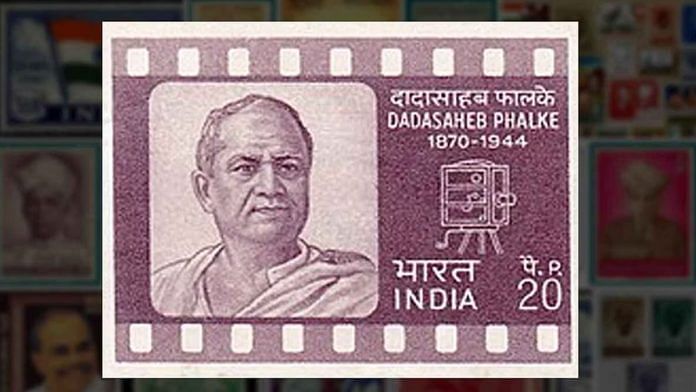It took decades for Dhundiraj Govind Phalke to find his groove, the years marked by personal tragedy and failure. A painter, publisher, printer and photographer, he discovered his calling as a filmmaker and came to be revered as Dadasaheb Phalke only to give it all up at the peak of his career and move to what is now Varanasi.
Within a year of establishing Phalke Films Company in 1912, he made the silent movie, Raja Harishchandra (1913), which was India’s first full-length feature film—a commercial hit that marked the start of a vibrant industry. Today, 80 years after his death on 16 February 1944, Phalke is honoured as the ‘Father of Indian Cinema’.
The government’s highest award in cinema is named after him. Paresh Mokashi’s Marathi-language film on his life’s work, Harishchandrachi Factory (2009), was selected as India’s official entry to the Oscar Academy Awards in the Best Foreign Language Film category. And now, director and screenwriter SS Rajamouli is making a biopic, Made in India, based on Phalke’s life.
In 1914, he declined an offer to travel to London to make movies.
“I have to keep making films in my country so that it gets established as an industry at home,” he said.
Bringing women to the silver screen
Phalke, who was inspired by French filmmaker Alice Guy-Blaché’s silent movie, The Birth, the Life and the Death of Christ (1906), wanted to eulogise and celebrate India’s rich mythological and historical legacies. Shivendra Singh Dungarpur, director of the Film Heritage Foundation, agrees. According to him, when the British were screening Western films in India, Phalke used mythology as a tool to connect Indians to their roots – a simple yet revolutionary step. “It was very brave of him,” Dungarpur adds.
When Phalke made Raja Harishchandra, the very idea of a woman actor was anathema to society. He had to cast a man (Anna Salunke) to play the role of King Harishchandra’s wife, Queen Taramati.
But he rectified this in his second silent film, Mohini Bhasmasur (1913) when he offered the role of Parvati to Durgabai Kamat and that of Mohini to her teenage daughter Kamlabai Gokhale. Kamat, who was a single mother, was disowned by her community for accepting the role. But she paved the way for women to take on lead roles on the big screen.
Years later, Phalke cast his own daughter, Mandakini Phalke, in Lanka Dahan (1917) and Shri Krishna Janma (1918).
“Having his own daughter enter the field was really something that he took as an initiative to tackle how women were seen [on the big screen],” says Abhija Ghosh, professor of Cinema Studies at OP Jindal Global University.
Phalke made more than a hundred movies – over 90 feature-length and 27 short films – in a career that spanned nearly two decades.
Phalke’s wife, Saraswatibai, too, played an important role in Indian cinema. Theirs was a working relationship, though her contribution is eclipsed by that of her husband’s. She was India’s first-ever film editor, having worked on films like Raja Harishchandra.
“Filmmaking was a new medium. He had to tell stories that would attract people. So people were intrigued because they could see gods and goddesses on screen,” says Ghosh.
Also read: ‘Rhythm king’ OP Nayyar faced AIR bans for music that was ‘too trendy, westernised’
Dadsaheb Phalke: Magician, photographer, filmmaker
Dadsaheb Phalke was born in 1870 in the Trimbak city of Nashik, Maharashtra to Sanskrit scholar Govind Sadashiv Phalke and his wife Dwarkabai. He completed his matriculation from Bombay in 1885 and went on to pursue a year-long drawing course at the city’s Sir JJ School of Art. Subsequently, Phalke enrolled at Kala Bhavana in Baroda (now Vadodara) in Gujarat, where he took lessons in oil and water painting. According to The Indian Express, this is also where he “gained knowledge about architecture as well as photography.”
In the early stages of his career, Phalke started a photography business in Baroda. According to Cinemaazi, an archive and research centre set up by the Indian Cinema Heritage Foundation, the business couldn’t thrive due to the misconception that photography “sucked the energy out of a person and led to bad consequences”
Phalke went on to paint stage curtains for theatre companies and even picked up magic tricks from a German magician touring Baroda at the time. According to Cinemaazi, by the end of 1901, Phalke “began performing magic under the name ‘Professor Kelpha’, a combination of the letters of his last name.”
“Phalke was using magic tricks in his films. He would make gods and goddesses appear and disappear. Soon, he became famous for that,” says Ghosh.
To hone his craft, Phalke sold his insurance policy and used the money to go to England to study filmmaking, says Asha Batra, co-founder of Cinemaazi.
From editing and shooting to costume design, Phalke did everything, adds Batra. “Slowly, people started joining him and the whole business started. He brought a shift to cinema.”
Also read: Lenin to Gandhi & Einstein, the controversial cross-continental legacy of CPI founder MN Roy
Transitioning to talkies
With success came financial support, and by 1918, Phalke had launched the Hindustan Cinema Films Company in partnership with five businessmen from Mumbai. But around 1920, he relocated to Varanasi with his family in what he called ‘cinematic sanyas’. While on this break, he produced a semi-autobiographical play, Rangbhoomi.
His films remained popular and successful up until sound was introduced in films. India’s silent storyteller couldn’t make the transition to the talkies. He made just one ‘talking film’, Gangavataran (1937), paving the way for others to assume the mantle.
Two decades after his death, the Indian government announced the Dadasaheb Phalke Award in 1969, to commemorate artistes and their contribution to cinema.
“He invented cinema in India. The way Gandhi is remembered through things such as his face on currency, Phalke is remembered through the award,” says Dungarpur.
(Edited by Zoya Bhatti)



